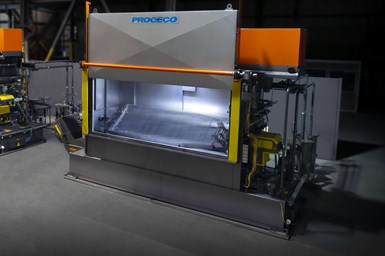Complete Cleaning/Drying of EV Battery Trays
This parts washer specifically developed to clean and dry EV battery trays has a processing time of less than 100 seconds per part and processes two battery trays per cycle.
The Typhoon-BTW Battery Tray Washer has a reciprocating nozzle manifold with precision-aimed nozzles that surround the workpiece — traveling back and forth along the length of the battery tray — positioned in a sideways vertical orientation. The high pump flow floods the battery trays with cleaning solution to effectively wash away debris in hard-to-reach places. Photo Credit: Proceco Ltd.
The manufacturing of electric vehicles (EVs) and their parts are quickly becoming a priority for automotive OEMs and their suppliers. The EV segment's growth brings many new challenges, including thoroughly cleaning and drying the compartment used to house the battery or the battery tray located under the vehicle.
A battery tray must accommodate for passenger safety, assist with heat dissipation and protect the battery from harsh environments and collision damage. That’s why it is critical that no metallic chips or trapped liquid from machining interfere with battery functionality. Much like small, intricate turned metal parts, these aluminum battery trays contain many openings and holes that can trap chips and debris that must be cleaned out before final assembly.
Featured Content
How do we remove all the chips? The cleanliness criteria and chip concerns are challenging to address in a standard parts washer. Without rotation, thorough cleaning is unattainable, as chips typically remain trapped inside the extrusions and are likely to dislodge during transport to the OEM or during the warranty period.
However, Proceco Ltd. has developed a washer specifically for this part. The Typhoon-BTW Battery Tray Washer enables these battery trays to be loaded and clamped into a servo-controlled rotating cradle. The rotation significantly improves the cleaning and flushing of debris that would otherwise remain trapped in the openings. The rotation also assists with draining the battery tray for better drying.
With a compact footprint and processing time of less than 100 seconds per part, the tray washer processes two battery trays per cycle. It has a reciprocating nozzle manifold with precision-aimed nozzles that surround the workpiece — traveling back and forth along the length of the battery tray — positioned in a sideways vertical orientation. The high pump flow floods the battery trays with cleaning solution to effectively wash away debris in hard-to-reach places.

On the left is debris prior to cleaning with the Typhoon-BTW Battery Tray Washer. On the right is the cleaned part by the washer. This washer enables EV battery trays to be loaded and clamped into a servo-controlled rotating cradle. The rotation significantly improves the cleaning and flushing of debris that would otherwise remain trapped in the openings. Photo Credit: Proceco Ltd.
In addition, the system is designed for integration into an assembly line with robotic loading and unloading.
Can we get the battery trays completely dry? Perception plays a significant role in gauging dryness results. What is dry enough? Dryness requirements may be necessary for downstream processes or may only be a desire from the end user. In general, drying should consider five key factors: substrate material, energy input (heat and air circulation), time, orientation and allowable part temperature at the end of the process.
The many openings and holes that battery tray structures contain can trap liquid accumulated during the cleaning process. Cycle time is often limited, reducing the time required for complete dryness. When time is limited, the tendency is to throw energy at the problem. However, too much heat is costly and can influence the final part temperature. Because the battery tray has many areas that can trap liquid, it is essential to design features that can remove liquid in short cycle times and without increasing energy. The part rotation and reciprocating high-velocity air knives incorporated into the BTW assist in releasing trapped fluid from the many openings in the battery tray.
Attempting to dry those last persistent fluid droplets could prove futile since they will likely flash dry within minutes. Any remaining droplets will likely evaporate from the retained heat in the workpiece after cleaning.
About the Author
Robert Burns, president of Proceco, has been working with the company since 1980. Robert holds a degree in mechanical engineering and a Diploma in Applied Management. In his spare time, he enjoys reading and practicing outdoor activities such as mountain biking, skiing, and scuba diving.
RELATED CONTENT
-
Custom Tooling, Workholding Help Whip Rotors Into Shape
Whipple Superchargers uses unique form tools and dead-length-collet workholding for its B-axis turn-mill enabling it to create more accurate rotors for its brand of engine power-adders.
-
Tips for Cleaning Oily Parts
Degreasers are the best option for cleaning parts machined with oil. Vacuum degreasers are recommended for cleaning complex parts.
-
Attaining Ten-Millionths Bore Accuracy
Conventional honing has been continuously improved and automated, now allowing boring accuracies to be measured in millionths.







